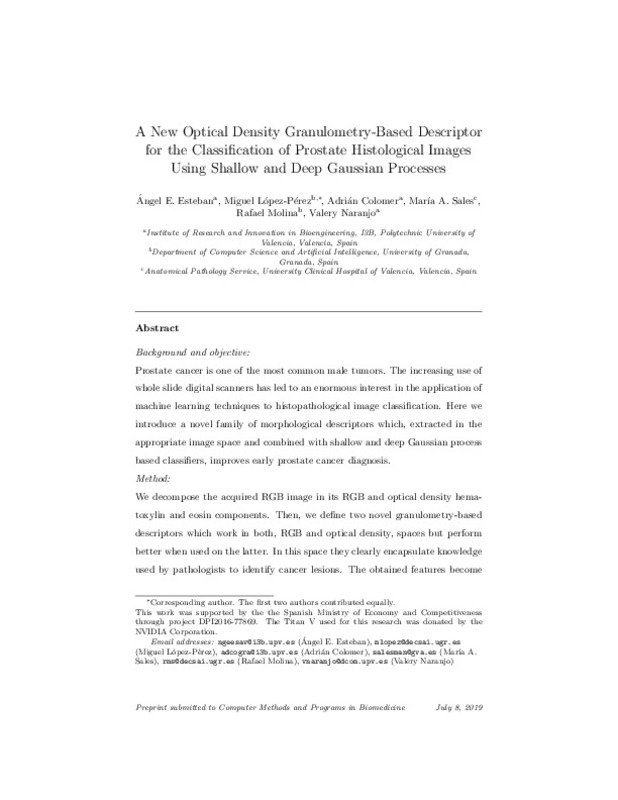JavaScript is disabled for your browser. Some features of this site may not work without it.
Buscar en RiuNet
Listar
Mi cuenta
Estadísticas
Ayuda RiuNet
Admin. UPV
A New Optical Density Granulometry-Based Descriptor for the Classification of Prostate Histological Images Using Shallow and Deep Gaussian Processes
Mostrar el registro sencillo del ítem
Ficheros en el ítem
| dc.contributor.author | Esteban, A. E.
|
es_ES |
| dc.contributor.author | López-Pérez, Miguel
|
es_ES |
| dc.contributor.author | Colomer, Adrián
|
es_ES |
| dc.contributor.author | Sales, Maria A.
|
es_ES |
| dc.contributor.author | Molina, Rafael
|
es_ES |
| dc.contributor.author | Naranjo Ornedo, Valeriana
|
es_ES |
| dc.date.accessioned | 2020-10-04T03:32:20Z | |
| dc.date.available | 2020-10-04T03:32:20Z | |
| dc.date.issued | 2019-09 | es_ES |
| dc.identifier.issn | 0169-2607 | es_ES |
| dc.identifier.uri | http://hdl.handle.net/10251/151053 | |
| dc.description.abstract | [EN] Background and objective Prostate cancer is one of the most common male tumors. The increasing use of whole slide digital scanners has led to an enormous interest in the application of machine learning techniques to histopathological image classification. Here we introduce a novel family of morphological descriptors which, extracted in the appropriate image space and combined with shallow and deep Gaussian process based classifiers, improves early prostate cancer diagnosis. Method We decompose the acquired RGB image in its RGB and optical density hematoxylin and eosin components. Then, we define two novel granulometry-based descriptors which work in both, RGB and optical density, spaces but perform better when used on the latter. In this space they clearly encapsulate knowledge used by pathologists to identify cancer lesions. The obtained features become the inputs to shallow and deep Gaussian process classifiers which achieve an accurate prediction of cancer. Results We have used a real and unique dataset. The dataset is composed of 60 Whole Slide Images. For a five fold cross validation, shallow and deep Gaussian Processes obtain area under ROC curve values higher than 0.98. They outperform current state of the art patch based shallow classifiers and are very competitive to the best performing deep learning method. Models were also compared on 17 Whole Slide test Images using the FROC curve. With the cost of one false positive, the best performing method, the one layer Gaussian process, identifies 83.87% (sensitivity) of all annotated cancer in the Whole Slide Image. This result corroborates the quality of the extracted features, no more than a layer is needed to achieve excellent generalization results. Conclusion Two new descriptors to extract morphological features from histological images have been proposed. They collect very relevant information for cancer detection. From these descriptors, shallow and deep Gaussian Processes are capable of extracting the complex structure of prostate histological images. The new space/descriptor/classifier paradigm outperforms state-of-art shallow classifiers. Furthermore, despite being much simpler, it is competitive to state-of-art CNN architectures both on the proposed SICAPv1 database and on an external database | es_ES |
| dc.description.sponsorship | This work was supported by the Ministerio de Economia y Competitividad through project DPI2016-77869. The Titan V used for this research was donated by the NVIDIA Corporation | es_ES |
| dc.language | Inglés | es_ES |
| dc.publisher | Elsevier | es_ES |
| dc.relation.ispartof | Computer Methods and Programs in Biomedicine | es_ES |
| dc.rights | Reserva de todos los derechos | es_ES |
| dc.subject | Prostate cancer | es_ES |
| dc.subject | Histopathological Images | es_ES |
| dc.subject | Gaussian Processes | es_ES |
| dc.subject | Variational Inference | es_ES |
| dc.subject | Granulometries | es_ES |
| dc.subject | Deep Gaussian Processes | es_ES |
| dc.subject.classification | TEORIA DE LA SEÑAL Y COMUNICACIONES | es_ES |
| dc.title | A New Optical Density Granulometry-Based Descriptor for the Classification of Prostate Histological Images Using Shallow and Deep Gaussian Processes | es_ES |
| dc.type | Artículo | es_ES |
| dc.identifier.doi | 10.1016/j.cmpb.2019.07.003 | es_ES |
| dc.relation.projectID | info:eu-repo/grantAgreement/MINECO//DPI2016-77869-C2-1-R/ES/SISTEMA DE INTERPRETACION DE IMAGENES HISTOPATOLOGICAS PARA LA DETECCION DE CANCER DE PROSTATA/ | es_ES |
| dc.rights.accessRights | Abierto | es_ES |
| dc.contributor.affiliation | Universitat Politècnica de València. Departamento de Comunicaciones - Departament de Comunicacions | es_ES |
| dc.description.bibliographicCitation | Esteban, AE.; López-Pérez, M.; Colomer, A.; Sales, MA.; Molina, R.; Naranjo Ornedo, V. (2019). A New Optical Density Granulometry-Based Descriptor for the Classification of Prostate Histological Images Using Shallow and Deep Gaussian Processes. Computer Methods and Programs in Biomedicine. 178:303-317. https://doi.org/10.1016/j.cmpb.2019.07.003 | es_ES |
| dc.description.accrualMethod | S | es_ES |
| dc.relation.publisherversion | https://doi.org/10.1016/j.cmpb.2019.07.003 | es_ES |
| dc.description.upvformatpinicio | 303 | es_ES |
| dc.description.upvformatpfin | 317 | es_ES |
| dc.type.version | info:eu-repo/semantics/publishedVersion | es_ES |
| dc.description.volume | 178 | es_ES |
| dc.identifier.pmid | 31416557 | es_ES |
| dc.relation.pasarela | S\390943 | es_ES |
| dc.contributor.funder | Ministerio de Economía y Competitividad | es_ES |







![[Cerrado]](/themes/UPV/images/candado.png)

